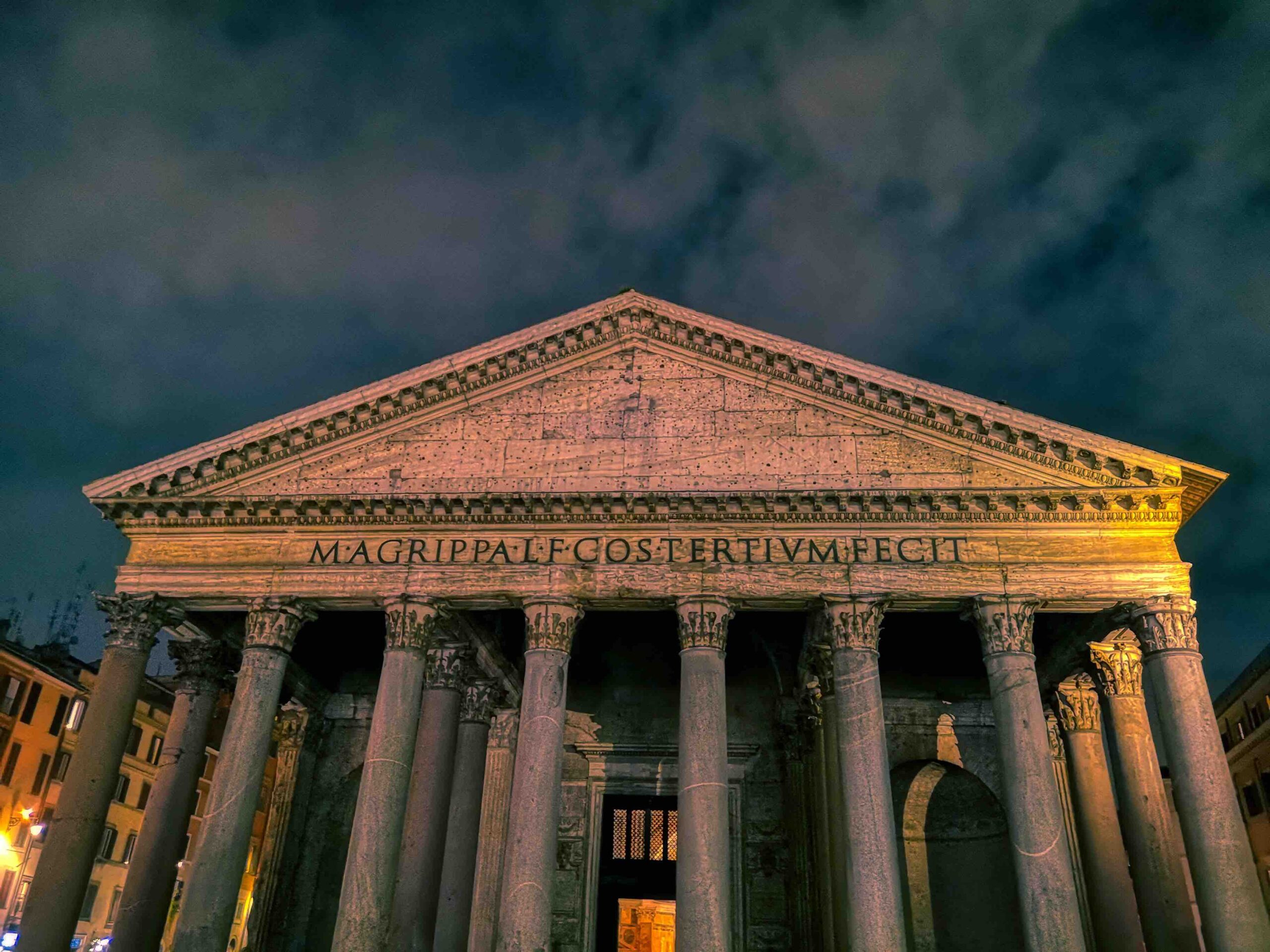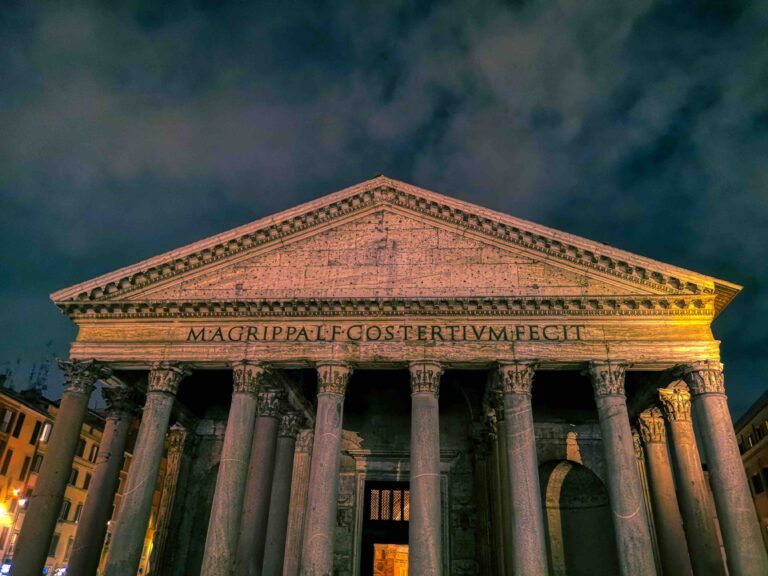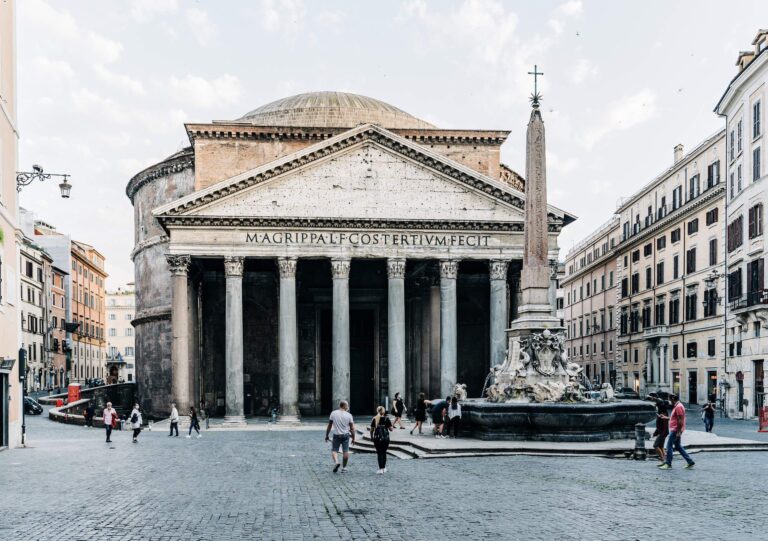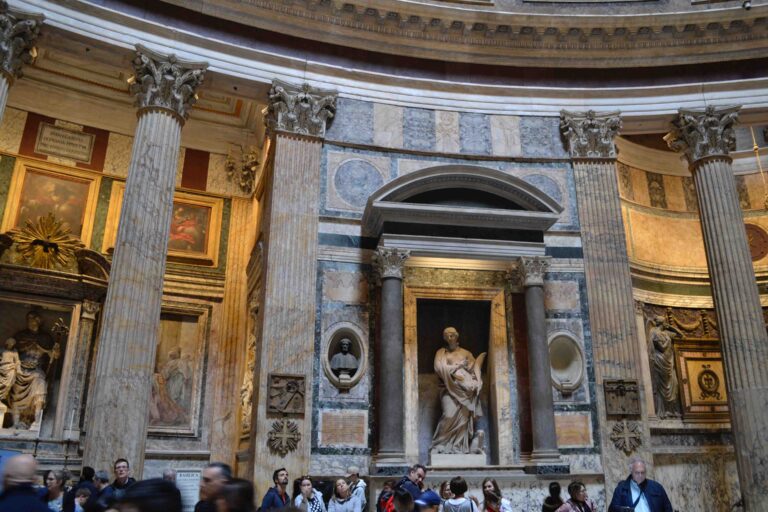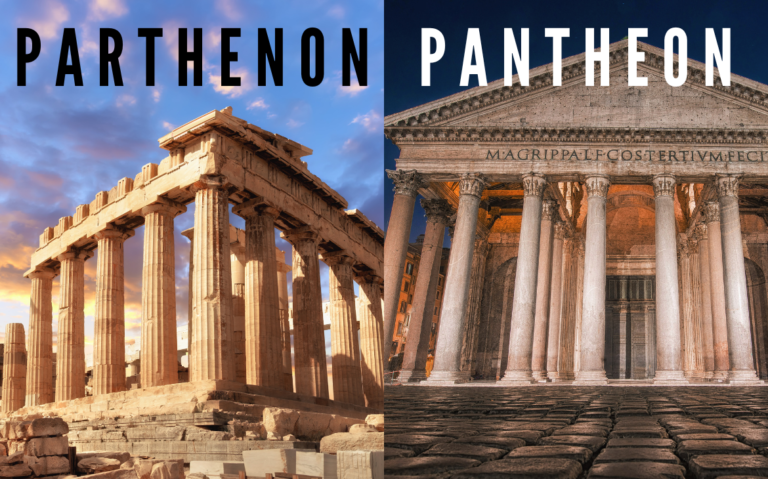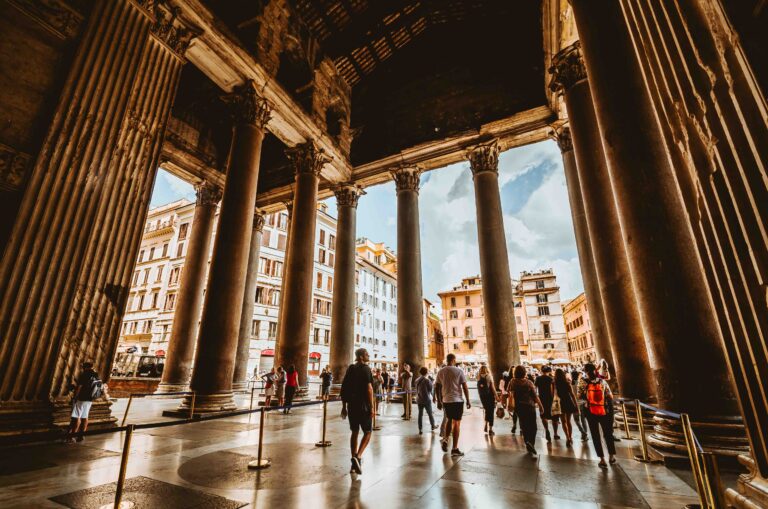Standing in the heart of Rome, looking up at a massive ancient dome with a perfect circle of sky visible through its center, you might wonder how something this incredible has survived for so long. The rain falls straight through that opening, just as it did when Roman emperors walked these same marble floors. Children chase pigeons across the piazza outside while tourists crane their necks in amazement inside. This is the Pantheon, and it has been witnessing human life unfold for nearly two thousand years.
So how old is the Pantheon in Rome? The building you can visit today is approximately 1,900 years old. Emperor Hadrian completed it around 126 AD, making it older than almost every cathedral, castle, and monument you can think of in Europe. What makes this even more remarkable is that the Pantheon isn’t a ruin. It’s not a pile of romantic rubble or a reconstruction. It’s the real thing, still standing, still functioning, still taking your breath away just like it did for people in togas all those centuries ago.
Walking into the Pantheon feels like stepping through a portal in time. The doors you push open are the original bronze doors from ancient Rome. The floor beneath your feet has been walked on for 1,900 years. The dome above your head remains the largest unreinforced concrete dome ever built, and no one has figured out how to top it even with modern technology. This isn’t just an old building. It’s a miracle of survival, engineering genius, and sheer luck that somehow made it through wars, earthquakes, floods, and the rise and fall of empires.
But the story of how old the Pantheon really is gets a bit complicated. There’s a mystery inscribed right on the front of the building that confused historians for centuries. And understanding the true age of this ancient wonder helps explain why Rome continues to draw millions of visitors who want to stand where emperors once stood and look up at the same sky the ancient Romans saw.
The Real Age of the Pantheon: Sorting Out the Timeline
Here’s where things get interesting. If you visit the Pantheon and read the inscription across the front, it says the building was constructed by Marcus Agrippa during the consulship of his third term. That dates it to around 27 BC, which would make it over 2,000 years old. For a long time, people believed this. But the inscription tells only part of the story.
The Pantheon standing today was actually built by Emperor Hadrian between 118 and 126 AD. That makes it roughly 1,898 years old as we stand here in 2024. So what happened? Why does the building claim to be older than it really is?
The original Pantheon was indeed built by Marcus Agrippa around 27 to 25 BC. Agrippa was the right hand man of Emperor Augustus, and he constructed a temple dedicated to all the Roman gods. That building stood for about a century before disaster struck. A major fire during the reign of Emperor Domitian around 80 AD damaged it severely. Then lightning struck the building in 110 AD, causing even more destruction and another fire.
When Hadrian became emperor, he decided to completely rebuild the Pantheon. But here’s the fascinating part. Hadrian was known for being modest about taking credit for his building projects. He kept Agrippa’s original inscription on the new building as a tribute to the first builder. This small act of humility confused scholars for nearly 2,000 years until archaeological evidence finally proved that the current structure dates to Hadrian’s time, not Agrippa’s.
The construction techniques, brick stamps, and analysis of the materials all point to the early second century AD. The building we see today, with its magnificent dome and perfect proportions, is Hadrian’s vision brought to life. So when someone asks how old is the Pantheon in Rome, the accurate answer is that the current building is from 126 AD, making it nearly 1,900 years old.
Why Has the Pantheon Survived Almost 2,000 Years?
This question amazes architects and historians even today. Rome is filled with ruins. The Forum is a collection of broken columns and crumbling walls. The Colosseum has lost huge chunks of its outer walls. Temples dedicated to various Roman gods were either destroyed, repurposed, or simply fell apart over the centuries. So why is the Pantheon still standing in such remarkable condition?
The answer comes down to three main factors: brilliant engineering, continuous use, and a bit of luck.
First, the engineering. Hadrian’s architects created something that still baffles modern engineers. The dome of the Pantheon measures 142 feet across, and the height from the floor to the oculus at the top is also exactly 142 feet. This means you could fit a perfect sphere inside the building. But creating a dome this massive presented enormous challenges.
The Romans solved this problem with innovative concrete work. They used different types of concrete as the dome rose higher. The base contains heavy concrete mixed with dense travertine and brick. As the dome curves upward, the concrete becomes progressively lighter. Near the top, they mixed the concrete with pumice, a volcanic rock so light it can float in water. This gradual reduction in weight was crucial to keeping the dome from collapsing under its own mass.
The coffered ceiling you see inside isn’t just decorative. Those recessed squares reduce the weight of the dome even further while adding structural strength. Each coffer is slightly smaller as you look toward the oculus, creating an optical illusion that makes the dome appear even higher than it is.
Then there’s the oculus itself, that 27 foot wide opening at the very top. It’s the only source of natural light in the entire building. You might think having a huge hole in the roof would be a structural weakness, but it actually serves multiple purposes. It reduces the weight at the dome’s most vulnerable point. It allows the concrete to expand and contract with temperature changes without cracking. And it creates a natural ventilation system that has kept the building’s interior environment stable for centuries.
The floor has a slight slope and drainage holes that handle the rain coming through the oculus. On rainy days, watching the rain fall in a perfect cylinder of water through that opening is one of the most magical experiences you can have in Rome. The drainage system installed 1,900 years ago still works perfectly.
But engineering alone didn’t save the Pantheon. Continuous use protected it in ways that no amount of clever construction could.
In 609 AD, Byzantine Emperor Phocas gave the Pantheon to Pope Boniface IV. The Pope consecrated it as a Christian church dedicated to St. Mary and all the Christian martyrs. It became known as Santa Maria ad Martyres, a name it technically still holds today. This conversion to a church saved the building’s life.
Across Rome, pagan temples were being abandoned, stripped of their valuable materials, or demolished. The medieval Romans treated ancient buildings as quarries, mining them for marble, bronze, and building stone for new construction. The Pantheon’s transformation into a church meant it was protected, maintained, and valued. Christians preserved a pagan temple because it had become their own sacred space.
The building did suffer some losses. In 1625, Pope Urban VIII had bronze stripped from the ceiling of the portico to make cannons for Castel Sant’Angelo and to create the famous baldachin in St. Peter’s Basilica. Romans sarcastically commented that what the barbarians didn’t do, the Barberini did, referring to the Pope’s family name. But overall, the church status kept the Pantheon intact while other Roman monuments crumbled.
The luck factor came into play too. The Pantheon survived earthquakes that toppled other structures. It weathered floods from the Tiber River. It made it through the sack of Rome by various invading armies. When you consider everything this building has endured over 1,900 years, its survival seems almost miraculous.
A Walk Through Time: The Pantheon’s Long History
To really understand how old the Pantheon is, it helps to walk through its timeline and see what was happening in the world as this building stood witness.
When Agrippa built the original Pantheon around 27 BC, Julius Caesar had been dead for less than 20 years. Cleopatra had just died. The Roman Empire was still young and growing. That first building served as a temple where Romans came to honor all their gods at once.
When fire damaged the structure in 80 AD, Mount Vesuvius had just erupted the year before, burying Pompeii and Herculaneum. The Colosseum was brand new, having been completed that same year. Rome was at the height of its power.
The lightning strike in 110 AD came during the reign of Trajan, considered one of Rome’s greatest emperors. The empire had reached its maximum size, stretching from Scotland to the Sahara Desert, from the Atlantic Ocean to the Persian Gulf.
When Hadrian rebuilt the Pantheon between 118 and 126 AD, he was creating a statement about Roman engineering superiority. Hadrian traveled extensively throughout the empire and brought back architectural ideas from Greece, Egypt, and the East. The Pantheon represents a fusion of Roman engineering with Greek aesthetic ideals.
After its consecration as a church in 609 AD, the Pantheon witnessed the collapse of the Western Roman Empire, the Dark Ages, and the medieval period. Vikings attacked Rome in the 9th century, but the Pantheon stood firm. The building became a fortress at times during the unstable medieval period, its massive walls and strategic location making it a stronghold during conflicts.
The Renaissance brought new appreciation for the Pantheon’s classical beauty. Artists and architects studied its proportions and tried to understand its construction secrets. When the great painter Raphael died in 1520 at just 37 years old, he was buried in the Pantheon at his own request. His tomb remains there today, a place of pilgrimage for art lovers.
More Italian notables were buried there over the centuries. Kings Vittorio Emanuele II and Umberto I have tombs in the Pantheon, as does Queen Margherita of Savoy. The building that started as a temple to pagan gods, became a Christian church, and then evolved into a national monument and mausoleum for Italian royalty.
Throughout all these changes, regular people kept coming. They came to pray, to admire, to seek shelter from rain, to marvel at the architecture. The Pantheon has never stopped being used. There has never been a time in nearly 2,000 years when the building sat empty and abandoned. This continuous human presence, this unbroken chain of people walking through those bronze doors, connects us directly to the ancient Romans who built it.
How the Pantheon Compares to Other Ancient Buildings
When you ask how old is the Pantheon in Rome compared to other famous landmarks, the answer really highlights how special this building is.
The Colosseum was completed in 80 AD, making it about 45 years older than the current Pantheon. But look at the condition of each building. The Colosseum has lost much of its outer wall and all of its interior floors. It’s a magnificent ruin. The Pantheon is still a complete, functioning building.
The Roman Forum contains structures from various periods, some older than the Pantheon. But they’re mostly broken columns, partial walls, and reconstructed temples. You need a guide and a lot of imagination to picture what the Forum once looked like. At the Pantheon, you’re seeing essentially what Hadrian saw.
Looking beyond Rome, the Pantheon is older than almost every famous building in Europe. The Hagia Sophia in Istanbul was completed in 537 AD, more than 400 years after the Pantheon. Notre Dame Cathedral in Paris wasn’t started until 1163, over 1,000 years younger than the Pantheon. Westminster Abbey in London dates to the 13th century. Every castle you can think of in England, France, Germany, or Spain is younger than the Pantheon.
Even more impressive, the Pantheon’s dome remained the largest in the world until the 15th century, when Brunelleschi built the dome of Florence Cathedral. That means the Pantheon held the record for the world’s largest dome for about 1,300 years. And technically, it’s still the largest unreinforced concrete dome ever built. Modern domes use steel reinforcement bars. The Pantheon’s dome is just concrete, relying purely on its shape and the genius of its design to stay up.
The Great Pyramid of Giza is much older, built around 2560 BC. But the Pyramid is solid stone. It’s impressive but simple in concept. The Pantheon is an enclosed space with a dome that seems to defy gravity. It’s a more complex engineering achievement.
What makes the Pantheon unique isn’t just its age. It’s the combination of age, completeness, and continued use. You can walk into this building and experience ancient Roman architecture exactly as it was intended. You’re not looking at a ruin or a reconstruction. You’re stepping into the real thing.
What You’ll Experience Inside This Nearly 2,000 Year Old Wonder
Visiting the Pantheon today feels surreal because the experience hasn’t changed much in 1,900 years. Sure, the statues of pagan gods are gone, replaced by Christian altars and artwork. But the space itself, the proportions, the light, the atmosphere remain as they were.
As you approach, you’ll see the massive portico with its 16 Corinthian columns. Each column is 39 feet tall and carved from a single piece of Egyptian granite. The Romans quarried these columns in Egypt, transported them down the Nile River, shipped them across the Mediterranean Sea, and hauled them through Rome to this spot. The logistics of moving these massive stones with ancient technology is mind boggling.
The bronze doors are original. Think about that for a moment. You’re touching the same doors that Roman senators touched 1,900 years ago. Very few things in this world offer that kind of direct, physical connection to antiquity.
Then you step inside, and the space opens up in a way that feels impossible. The interior is dim because the only light comes from the oculus. Your eyes adjust, and you start to notice details. The colored marble floor, mostly original, creates geometric patterns. The walls have niches that once held statues of gods and now contain Christian altars and artwork.
But everything pulls your gaze upward to the dome. The coffered ceiling creates a rhythm that draws your eye toward the oculus. And there it is, that perfect circle of sky. The light streaming through moves across the interior as the day progresses, creating a living sundial effect. The Romans understood this. The building functioned as a solar calendar, with the light hitting specific points on particular days.
If you visit on a rainy day, you’re in for something special. The rain falls straight down through the oculus in a neat column. You can watch it splash on the floor, where it drains away through holes that have been doing this job for nearly two millennia. There’s something profound about watching rain fall inside a building, knowing that Romans watched the same thing happen in this exact spot 1,900 years ago.
The acoustics deserve attention too. The dome creates interesting sound effects. Conversations happening across the room sound clear despite the distance. Music played in the Pantheon takes on an ethereal quality. The space was designed to impress, to make people feel small before the gods, and it still works.
You’ll find Raphael’s tomb along the wall, marked with a Latin inscription. Nearby are the tombs of the Italian kings and queens. Other artists and musicians are buried here too. The Pantheon started as a temple, became a church, and evolved into a national monument that houses Italy’s most honored dead.
Most visitors spend 20 to 30 minutes inside, walking around, taking photos, sitting on the stone benches to simply absorb the atmosphere. But you could easily spend an hour noticing small details. The way the marble is fitted together. The slight wear on the floor from millions of footsteps. The patches where ancient damage was repaired. Each detail tells a story about the building’s long life.
Planning Your Visit: Everything You Need to Know
If you’re planning a trip to Rome, the Pantheon should be at the top of your list. It’s located in the historic center at Piazza della Rotonda, easily walkable from other major attractions. The piazza itself is worth experiencing, filled with cafes, street artists, and a beautiful fountain with an Egyptian obelisk.
The Pantheon is open to visitors every day. Monday through Saturday, it opens at 9 AM and closes at 7 PM. On Sundays, hours are 9 AM to 6 PM. These hours can change for religious services or special events, so checking ahead is smart. The building is still an active church, so occasionally it closes to tourists for mass or other religious ceremonies.
Here’s great news for budget travelers. Entry to the Pantheon is free. After years of charging admission, they went back to free entry, though you need to book a time slot online. This reservation system helps manage the crowds and ensures you can actually get in to see this ancient wonder. Booking ahead takes just a few minutes and saves you from potentially being turned away at the door.
Since the Pantheon is a church, modest dress is required. This means no bare shoulders, no shorts or short skirts above the knee, and no hats inside. If you show up in beach clothes, they’ll turn you away. During hot Roman summers, bring a light scarf or shawl you can throw over your shoulders.
The best time to visit depends on what you want to experience. Early morning, right when it opens at 9 AM, offers the smallest crowds. You might even have a few moments where the space feels almost empty, which is rare. The light in the morning has a soft quality that makes the interior feel peaceful.
Late afternoon brings dramatic lighting. As the sun gets lower in the sky, the angle of light through the oculus creates striking effects. The rays of light become more visible in the dusty air, creating those classic photos you see of the Pantheon.
Midday is the busiest time, especially during summer when cruise ships dump thousands of tourists into Rome. If you don’t like crowds, avoid visiting between 11 AM and 2 PM.
Rainy days offer a unique experience. Yes, you might get a bit wet, but watching rain fall through the oculus is magical. Plus, bad weather keeps away some tourists, so you might find the crowds more manageable.
Should you book a guided tour? This depends on how much context you want. The Pantheon is relatively simple to visit on your own. You walk in, look around, walk out. But here’s what you miss without a guide: the stories behind the architecture, the explanation of how the dome was built, the identification of which marbles came from which parts of the empire, the history of the tombs, and countless small details that bring the ancient stones to life.
A good guide transforms the visit from “that was cool” to “I can’t believe what I just learned.” Tours typically last 60 to 90 minutes and cost between 20 and 40 euros per person. Many tour companies offer combination tours that include the Pantheon along with other nearby attractions like Piazza Navona, the Trevi Fountain, or the Roman Forum.
Skip the line tours can be worth it during peak season, though with the new reservation system, regular lines move fairly quickly. Private tours cost more but give you personalized attention and the flexibility to spend more time on aspects that interest you most.
Virtual reality tours have become available that use headsets to show you what the Pantheon looked like in ancient times, with its original decorations, statues, and bronze ceiling. These tech enhanced tours appeal to people who want to see beyond the current state of the building.
After visiting the Pantheon, stick around the piazza for a bit. The cafes offer overpriced but scenic spots to sit with a coffee or gelato while looking at the 1,900 year old monument. The area has been a gathering place for centuries, and people watching here connects you to that long tradition of Romans meeting and socializing in this square.
Insider Tips for Making the Most of Your Pantheon Visit
Here are some things that veteran visitors and locals know that can enhance your experience at this ancient building.
Book your free time slot as early as possible, especially if you’re visiting during busy seasons. Slots fill up days in advance. The reservation system was introduced to manage overtourism, and it works, but only if you plan ahead.
Photography is allowed inside, but be respectful. This is an active church, and people come here to pray, not just to sightsee. Flash photography is often discouraged as it disturbs other visitors and can damage artwork over time.
For the best photos, stand near the center of the building and shoot straight up at the dome. A wide angle lens helps capture the full scope of the space. If you want to photograph the exterior, morning light from around 8 to 10 AM is best for the facade.
The marble floor shows 1,900 years of wear. In certain spots near the entrance, you can see where the stone has been worn smooth by millions of footsteps. These worn spots are historical artifacts themselves.
Look for the tomb of Raphael on the left side as you enter. Many visitors miss it because they’re so focused on the dome. The inscription translates to “Here lies Raphael, by whom Nature feared to be outdone while he lived, and when he died, feared that she herself would die.”
Notice the different colored marbles in the interior. These came from all over the Roman Empire. Purple porphyry from Egypt. Yellow marble from North Africa. Green marble from Greece. The Pantheon was meant to represent the entire empire gathered in one place.
The drainage holes in the floor are original Roman engineering. On a rainy day, crouch down and watch how efficiently they handle the water coming through the oculus. This 1,900 year old drainage system still works perfectly.
Visit at different times of day if you can. The moving sunlight through the oculus creates completely different moods. An early morning visit and a late afternoon visit feel like experiencing two different buildings.
The piazza outside gets packed with tourists, but walk just one block in any direction and you’ll find quieter streets. The neighborhood around the Pantheon is filled with artisan shops, small churches, and local restaurants that tourists often miss.
For a great view of the Pantheon’s exterior, have an aperitivo at one of the cafes on the piazza around sunset. Yes, it’s touristy and overpriced, but watching the ancient building as the sky changes color behind it is worth the inflated cost of a Spritz.
Remember that religious services still happen here. If you’re lucky enough to be there during mass, the ancient space filled with Latin prayers and organ music provides a powerful reminder that this building has been a place of worship for over 1,400 years.
Amazing Facts About the Pantheon’s Age and Survival
The concrete in the Pantheon’s dome is still curing after 1,900 years. Concrete continues to strengthen over time through a chemical process, and the special Roman concrete used in the Pantheon has been getting harder and more durable for two millennia. Scientists studying the concrete have found that the Romans used a recipe involving volcanic ash that creates a chemical reaction producing extremely strong and long lasting material. Modern concrete typically lasts 50 to 100 years before it starts deteriorating. The Pantheon’s concrete has lasted 1,900 years and shows no signs of weakening.
The dome’s thickness varies from 21 feet at the base to less than 4 feet at the oculus. This gradual thinning, combined with the use of progressively lighter materials, allowed the Romans to build at a scale that wouldn’t be matched for over a thousand years.
Michelangelo, when asked to design the dome for St. Peter’s Basilica, studied the Pantheon extensively. He reportedly called it “angelic, not human design.” His dome for St. Peter’s is smaller in diameter than the Pantheon’s, showing the respect later architects had for this ancient achievement.
The Pantheon has inspired countless buildings around the world. Thomas Jefferson used it as inspiration for the Rotunda at the University of Virginia. The U.S. Capitol building features a dome influenced by the Pantheon. Countless government buildings, libraries, and monuments worldwide echo its design. An idea executed nearly 2,000 years ago continues to influence how we build today.
The bronze doors weigh about 20 tons and are nearly 2,000 years old. They’re the largest Roman bronze doors still functioning on their original hinges. The fact that they still open and close smoothly after all this time demonstrates the precision of Roman metalworking.
Temperature inside the Pantheon stays remarkably stable year round, thanks to the thermal mass of all that concrete and marble combined with the natural ventilation through the oculus. The Romans understood climate control without modern technology.
During World War II, the Pantheon was declared a protected monument, and both Allied and Axis forces respected this status. Even in the chaos of war, humanity recognized that some things transcend politics and conflict. The 1,900 year old building survived yet another crisis.
Frequently Asked Questions About the Pantheon
When was the Pantheon built? The current Pantheon was built between 118 and 126 AD under Emperor Hadrian, making it approximately 1,900 years old. An earlier version built by Marcus Agrippa around 27 BC was destroyed by fire.
How old is the Pantheon compared to the Colosseum? The Colosseum is slightly older, completed in 80 AD, while the current Pantheon was finished around 126 AD. However, the Pantheon is much better preserved than the Colosseum.
Why is the Pantheon so well preserved? Three main reasons: brilliant Roman engineering, conversion to a Christian church in 609 AD which protected it from destruction, and continuous use throughout its history which meant it was always maintained.
What does Pantheon mean? The word comes from Greek, meaning “temple to all the gods.” It was originally built as a temple where Romans could worship any god they chose.
Is the Pantheon free to visit? Yes, entry is currently free, though you need to book a time slot reservation online. This recent policy change makes visiting easier for budget conscious travelers.
What is the hole in the roof called? It’s called the oculus, Latin for “eye.” This 27 foot wide opening is the only source of natural light and serves important structural and environmental functions.
What happens when it rains in the Pantheon? Rain falls straight through the oculus onto the floor, where it drains away through original Roman drainage holes. The floor has a slight slope to help water flow toward these drains. Watching it rain inside the Pantheon is an unforgettable experience.
Can you get married in the Pantheon? Since it’s an active Catholic church, weddings can be held there, though this requires special permission from church authorities. Most couples find it easier to marry in other Roman churches.
Who is buried in the Pantheon? The artist Raphael has the most famous tomb. Italian kings Vittorio Emanuele II and Umberto I are buried there, along with Queen Margherita. Several other artists and notable Italians have tombs or memorial plaques in the building.
How long should you spend at the Pantheon? Most visitors spend 20 to 45 minutes. If you’re taking a guided tour, plan for 60 to 90 minutes. Architecture enthusiasts could easily spend two hours noticing details and absorbing the atmosphere.
What’s the best time to visit the Pantheon? Early morning right at opening time (9 AM) offers the smallest crowds. Late afternoon provides dramatic lighting. Rainy days create a magical atmosphere despite the weather.
Do you need tickets for the Pantheon? Entry is free, but you must book a time slot online in advance. This reservation system helps manage the millions of annual visitors and ensures you can actually get inside.
Is the Pantheon worth visiting? Absolutely. It’s one of the few places where you can experience ancient Roman architecture in its complete, original form. The engineering, history, and atmosphere make it one of Rome’s must see attractions.
What should you wear to the Pantheon? Modest clothing is required since it’s an active church. Cover your shoulders and knees. No hats inside. During summer, bring a light scarf you can use as a cover up.
Final Thoughts: Standing in 1,900 Years of History
There’s something deeply moving about standing inside the Pantheon and realizing that the floor beneath your feet has supported nearly 2,000 years of human history. Emperors walked here. Early Christians prayed here. Medieval pilgrims sought shelter here. Renaissance artists studied here. And now you’re here, part of an unbroken chain of people who have been awed by this space.
The question of how old is the Pantheon in Rome becomes less about a specific date and more about continuity. Yes, it was completed around 126 AD. But it’s not frozen in time. It has lived and evolved, changing from pagan temple to Christian church to national monument, always adapting, always surviving, always remaining relevant.
In a world where buildings rarely last beyond a century before being demolished for something newer, the Pantheon reminds us that great architecture transcends its era. The engineers who mixed that Roman concrete never imagined people would still be admiring their work in the 21st century. They couldn’t have predicted that tourists from countries that didn’t exist in their time would travel across oceans in flying machines to stand beneath their dome. But they built something that lasted anyway.
When you visit Rome, you’ll see many ruins that require imagination to appreciate. You’ll look at broken columns and try to picture the complete temples they once supported. You’ll walk through the Forum and reconstruct fallen buildings in your mind. But at the Pantheon, no imagination is required. It’s all there, real and complete, waiting for you to experience it exactly as the Romans did.
Book your visit, get there early, step through those ancient bronze doors, and look up at that impossible dome with its circle of sky. Feel the weight of 1,900 years of history around you. Stand in the rain if you’re lucky enough to visit on a wet day. Let this ancient building work its magic on you the same way it has for countless visitors across the centuries.
The Pantheon is more than just old. It’s a bridge connecting us to ancestors so distant they lived in a different world, yet built something we still can’t fully replicate. That connection, that tangible link to the ancient past, is what makes the Pantheon one of the world’s most extraordinary places.
And after 1,900 years, it’s still standing strong, still inspiring awe, still proving that some things, when built with genius and care, really can last forever.

